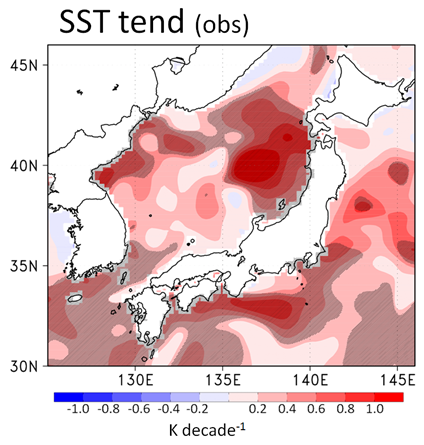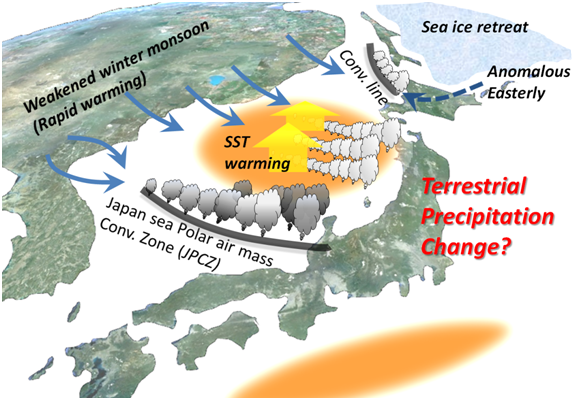Winter precipitation variability in Japan influenced by the interaction among atmosphere, ocean, and sea ice
| A03-K8. Winter precipitation variability in Japan influenced by the interaction among atmosphere, ocean, and sea ice | |
|---|---|
| PI | Tomonori SATO#(Associate Professor, Hokkaido University) |
[Doctral degree: #Meteorology]
The roles of sea surface temperature (SST) and sea ice anomalies in modulating the terrestrial precipitation around Japan is investigated using a regional atmospheric model and data analysis. Large amount of snowfall occurs during the cold season in northern Japan as the northwesterly winter monsoon carries abundant moisture from the Japan Sea. However, a relationship between the SST trend around Japan (Fig. 1) and long-term precipitation variation in Japan over the last few decades is unclear in spite of the recent SST warming. We will also focus on the possible influence of SST and sea ice changes on the typical convergence lines produced over the Japan Sea, such as the Japan sea Polar air mass Convergence Zone (JPCZ; Fig. 2). Since these convergence lines bring heavy snowfall events over the central and north Japan, it is important to understand the behavior of the convergence lines corresponding to the changes in SST, sea ice and winter monsoon.
The sensitivity experiments using a regional atmospheric model with horizontal mesh size of 10-20 km will be conducted over more than 10 years by changing atmosphere, SST and sea ice conditions.
Changes in SST and sea ice fraction around the Japanese island are very different among GCM projections for global climate change; therefore, we have to be mindful that the future climate around north Japan still contains large uncertainty. A series of sensitivity experiments on SST and sea ice will provide the response of winter precipitation around Japan to the future changes in the SST and sea ice, which helps reducing the uncertainties in the future climate prediction.

Fig. 1: Linear trend in winter SST during 1982/83-2007/08.

Fig. 2: Schematic illustration describing the outline of this study. The rapid air mass transformation over the ocean is modulated by the long-term changes in winter monsoon, SST, and sea ice.

